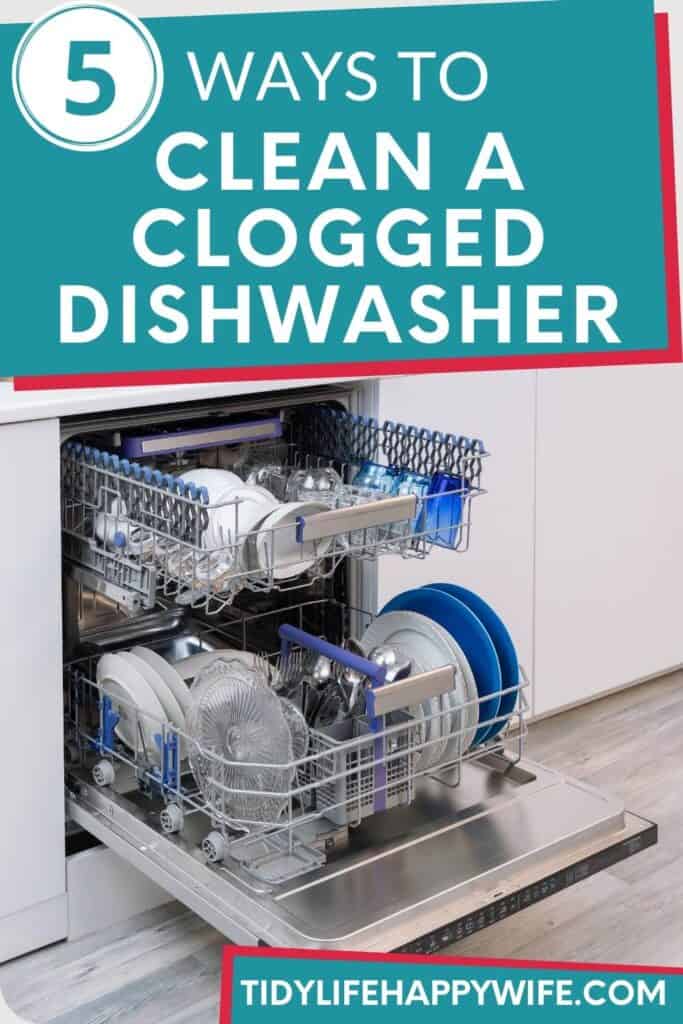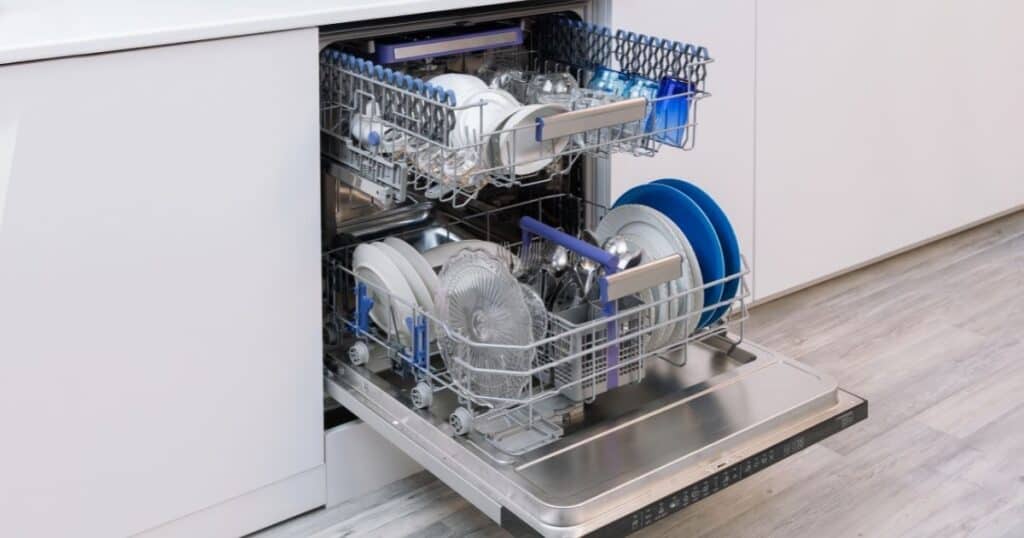A clogged dishwasher is a major pain in the neck no matter when it happens. Fortunately, it’s usually pretty easy to fix. Before you call an expensive service technician, try these 5 simple ways to clean a clogged dishwasher yourself.
How can I tell if my dishwasher is clogged?
If the dishes are still dirty or there’s a pool of water in the bottom of your dishwasher after the cycle completes, you likely have a drainage issue caused by a clog somewhere in the filter or plumbing.
Other signs of a clogged dishwasher include an unpleasant odor when you open the door, gurgling sounds while the dishwasher is running, a wet countertop around your air gap, or water backing up into your sink.
If you suspect you have a clog, here are some simple things you can do yourself to try to clean it out. You might even want to add a couple of them to your regular cleaning routine to help prevent clogs.

Make Sure the Cycle Wasn’t Interrupted
First things first, before you try any of these, check the cycle indicator light to see if the dishwasher actually ran through the entire cycle.
Most modern dishwashers have a cycle indicator light on the control panel. The indicator light will blink repeatedly if the cycle has been interrupted.
If you can’t find an indicator light, you can always just run the normal cycle again to see if that was the problem.
I can’t tell you how many times I’ve found dirty dishes and water in the bottom of the tub because somebody opened the door while the dishwasher was running, but neglected to push the reset button.
1. Clean Out the Dishwasher Filter
Did you just say “what filter”? You’re not alone. A lot of people don’t realize the dishwasher has a drain filter.
Most modern dishwashers have a filter basket located on the bottom of the dishwasher. Some might be covered with an additional screen to help keep big pieces of food out.
Remove any excess water from the bottom of the dishwasher with a sponge or a few towels. Locate the filter, and remove it.
If you have an older model or can’t find the filter, check your manual or search online for specific information on where your filter is located.
Remove any bits of food from the filter basket. Scrub it with a soft brush and warm water to remove any food particles and gunky buildup.
Clean out the filter reservoir and make sure there isn’t any trapped food or other debris in the reservoir. Reassemble and give it a try.
2. Run the Garbage Disposal to Clear Leftover Food
If the kitchen sink has a garbage disposal, the dishwasher drainage hose is usually connected to it for venting purposes. Residual food debris can create a garbage disposal clog that causes the dishwasher to drain poorly or not at all.
Run the garbage disposal for a few minutes while running the water to clear any residual food particles. Turn the garbage disposal off and let the water run for a couple more minutes.
Shut the water off and test the dishwasher cycle.
***Pro Tip: If your garbage disposal was installed recently, check to make sure the knockout plug was removed.
3. Check the Air Gap for Blockages
Dishwashers that aren’t connected to a garbage disposal should have an air gap that prevents the dirty water from flowing back into the dishwasher. If the air gap is clogged, it can prevent the dishwasher water from draining correctly.
Locate the air gap on the countertop near the sink. Slide the cover off of the air gap and clean out any food or debris that you see.
Run a short cycle on the dishwasher to test it out.
4. Flush the Drains with Hydrogen Peroxide and Baking Soda
If you have a clogged drain, you might be able to clear it by just flushing the drain pipes.
Make a thin slurry of hydrogen peroxide and baking soda. Pour the slurry down the kitchen sink drains and let it sit for 10 to 15 minutes, then flush with water for a few minutes.
The mixture creates a mild reaction that actually liquifies any greasy build-up in your drain lines. It’s much more effective in clearing greasy buildup than the popular white vinegar and baking soda combo.
***Pro Tip: I do this on a regular basis just to keep the drain lines clean. It works great in your bathroom drains too.

5. Clean the Plumbing Lines
This is usually my last resort before I call my local repair technician. It’s not the easiest solution, but I save a ton of money doing it myself.
Most of my drain pipes can easily be taken apart with basic tools, but if yours can’t, you might want to skip this and just call a plumber now.
Some of these lines might be partially transparent which makes it easy to spot clogs. If yours isn’t transparent, you’ll need to loosen the plumbing connections and remove the pipes to clean them out.
Here’s a list of the tools and supplies that work for most setups.
- Bucket or bowl to catch any residual water (I use a mop bucket)
- Towels to mop up any wet messes you might make
- Flathead screwdriver to loosen hose clamps
- Wrenches to loosen plumbing connections
- Bottle brush or old toothbrush to clean inside pipes and hoses
- Bowl of soapy water to clean brush between passes
Since you already have the tools and are likely sitting on the floor in front of the sink, you might as well disconnect, clean, and reconnect them all.
I suggest working one at a time. Disconnect one end, clean the inside walls of the pipe/tubing with a bottle brush or toothbrush. Rinse the brush off and do one more pass, then reconnect the pipe.
Once you’ve cleaned and reconnected everything, run hot water in the sink for a couple of minutes, then do a test run on the dishwasher.
What if I can’t clean the dishwasher clog?
If you’ve tried cleaning the clogs out of the garbage disposal, air gap, and drain pipes but weren’t successful, the problem is a little more complicated.
Chances are there is a clog in the drain line under your dishwasher, in the sewer line drainage system, or there’s some kind of mechanical issue like a faulty drain pump.
If you’re pretty handy, here are some helpful tips to troubleshoot and fix the dishwasher yourself, or it might be time to call a repair technician.